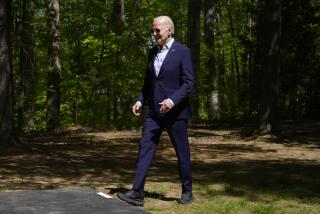Protection delayed for greater sage grouse
The greater sage grouse, a symbol of the West’s dwindling sagebrush landscapes, should be protected under the Endangered Species Act but won’t be for at least another year, Interior Department officials announced Friday.
Instead, the department issued a “warranted but precluded” designation for the bird, meaning that it meets scientific criteria for protection but that other species are a higher priority. Its status will be reviewed annually.
Listing the grouse as endangered or threatened could have frozen oil and gas projects across Western states, and probably would have ended greater sage grouse hunting, permitted by several states.
The designation leaves greater sage grouse management largely in the hands of state officials.
Even without the formal listing, federal officials said Friday they would review plans for new energy development on federal land -- including leasing areas for oil and gas drilling, wind turbines and solar panels -- to minimize the impact on grouse habitat.
“We must find common-sense ways of protecting, restoring and reconnecting the Western lands that are most important to the species’ survival, while responsibly developing much-needed energy resources,” Interior Secretary Ken Salazar said in announcing the decision.
Greater sage grouse populate the plains of Nevada, Wyoming, Oregon and other Western states. Conservationists consider them an indicator species for sagebrush ecosystems. The birds have lost about half of their historical range, and some scientists predict they could disappear from some regions within 30 to 100 years.
The split decision on the birds’ protection drew a mixed reaction from environmentalists, who sued the George W. Bush administration for refusing to declare the bird endangered.
Federal officials “got the science right but passed on the opportunity to fully protect this bird today,” George Fenwick, president of the American Bird Conservancy, said in a news release.
Joseph Kiesecker, a scientist with the Nature Conservancy, called the decision “a wake-up call” to improve federal land-use planning with an eye toward protecting sage grouse habitat.
The move upset some proponents of increased energy production, including lobbyist groups and conservative Western lawmakers.
Rep. Rob Bishop (R-Utah) called it “one more on a growing list of examples that this administration places environmental special interests before job creation” and “a direct attack on the hundreds of Western communities that depend on access to federal lands for ranching, livestock, mining and energy production.”
Kathleen Sgamma of the Independent Petroleum Assn. of Mountain States said she remained concerned that the designation could ultimately impede production and job growth.
More to Read
Start your day right
Sign up for Essential California for news, features and recommendations from the L.A. Times and beyond in your inbox six days a week.
You may occasionally receive promotional content from the Los Angeles Times.






